- Root Chakra
- Sacral Chakra
- Sloar Plexus Chakra
- Heart Chakra
- Throat Chakra
- Third Eye Chakra
- Crown Chakra
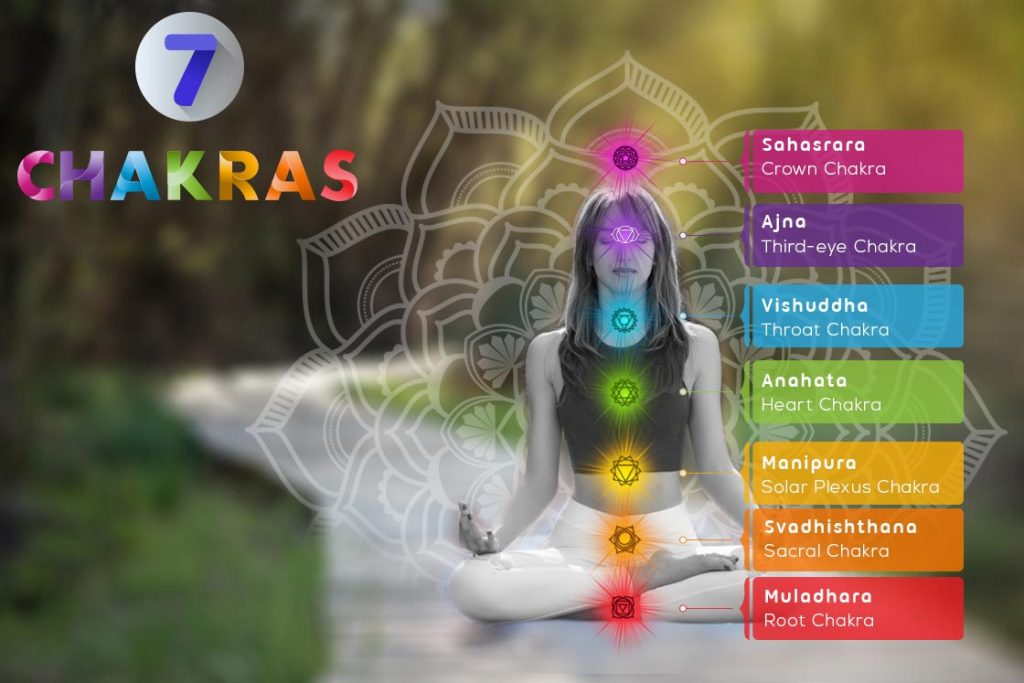
The concept of Chakras is closely attached to the energy. The energy within us, also which is manifested in the whole universe. The Universe is referred to as a system of many elements acting or fused together to function as a unit.
According to Tantric Buddhism and Hinduism, just like the Universe, Our body itself is believed to be made of five core elements Air, Space, Earth, Water, and Fire.
Concept of the Human Body
Breakdown the Universe, our body has small systems of cells working together, in which energy is flowing or moving constantly in the form of 5 elements, just like in the universe. There are constant changes occurring in our bodies because of these energies.
Different energies circulate through us continuously to establish and maintain our inner system that certainly affects our outer system as well. These energies are vital contributors to our behavior, mood, nature, conscience, and wellness.
Speaking of energies, many questions arises in the mind including, what is the source of these energies in our body? What makes up to the definitive but a vast system of human mechanism?
Henceforth, the Yogic system enables us to find the right sources of energy, their purpose, and meanings through Chakras.
What Is Chakra?
‘Prana – The Life‘ in certain major parts of our body constantly spinning to keep us alive and active. The spinning or rotating nature of Prana made these parts of the body, ‘centers of energy‘ also known as Chakras.
The word ‘Chakra’ (In Sanskrit Cakra) refers to ‘Wheel’ or ‘Disc’, which named because it’s made of the rotating motion of Prana.
Chakras are basically the junction points of Nadis in the body. Converging at certain points in our body, Anodea Judith stated in her book ‘The Wheels of Life‘, these Nadis form a junction we know as Chakra.
Where Nadis are the pathways of ‘Prana – life force’, Chakras are the distributor and purifier of the Prana.
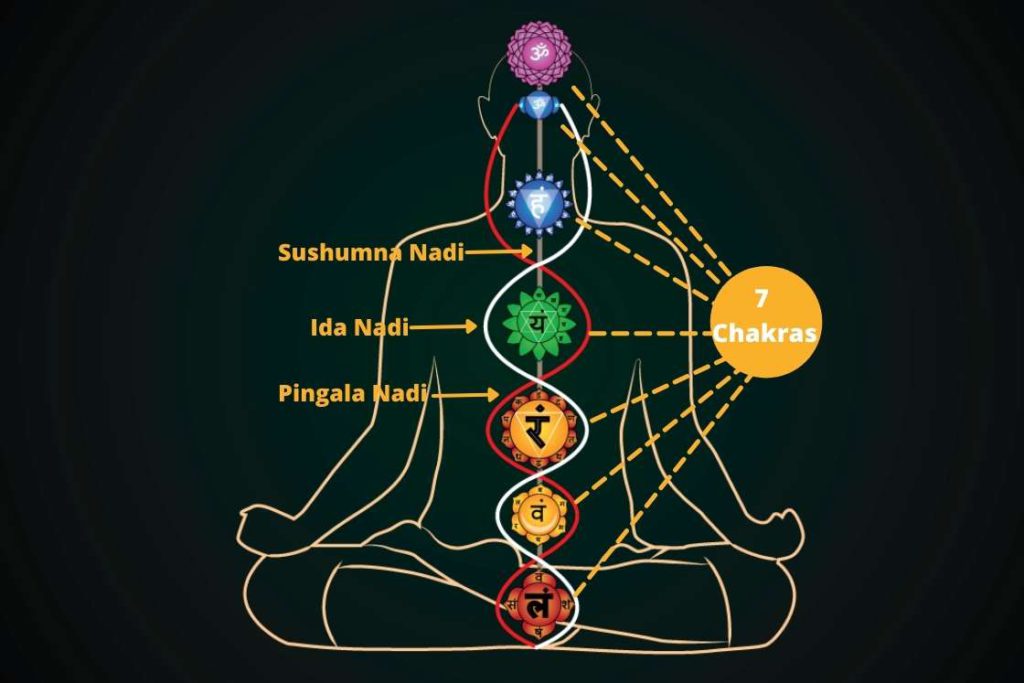
Indeed, Nadis always meets at junction points in a triangular shape but even after that these points are called Chakra, not Trikon (Triangular). The reason behind it is – Prana within Nadis. Prana introduces a motion at the junction points and motion (energy) always radiates in the circular form. This is how Chakra’s formation takes place.
3 States of Chakras
To understand the working of Chakras, each Chakra has the 3 states of activeness. Rate of rotation of Prana in each Chakra defines the state of Chakra at a particular time.
- The Overactive state of a chakra – When Prana spins at a higher rate than the normal one, chakra is said to be in overactive states. In this state, you will feel the excessive energy flow through corresponding organs of the overactive Chakra.
- The Balanced State of a chakra – When Prana spins at the normal rate so that energy neither excessively flow through certain organs nor in a deficient manner.
- The Underactive State of a chakra – When Prana spins slower than usual rate due to lack of attention or certain physical activity, chakra becomes underactive.
In both cases (overactive and underactive), there is a faulty flow of energy happens through the chakra, called Imbalanced or Blocked chakra.
If Chakras gets blocked, it may cause illness and other difficulties that are clearly visible whether behavioral or physical.
History of Chakras
The historical meaning of the word Chakra revolves around 600 BC where Chakras got mentioned first as psychic focal points of consciousness in the Upanishads. Yoga Sutras of Patanjali adopted the same in Circa 200 BC.
The etymology indicates that this concept of chakras (Wheels of life) first evolved in Hinduism and Tantric Buddhism. It first got developed around and introduced in Vedas, which was introduced by Upanishads and Yoga Sutras of Patanjali.
Different interpretations led to the discovery of a varying number of Chakras stating own understanding of Kundalini (the energy that is unleashed in creation, and lies coiled and sleeping at the base of the spine). The similar theory emerged in Sufism, later.
From India, the notion of Chakra as an energy center got carried forward to China, where, it was absorbed and harmonized with Chinese concepts of the flow of energy (Qi energy) replacing Kundalini.
Today, the chakra concept remains popular among the New Age Movement in the West. The Modern Age movements have led to an increased interest in the West regarding chakras.
How Many Chakras Are There?
Yoga formulations typically describe seven chakras, says Dr. Georg Feuerstein in his book Yoga Encyclopedia although additional chakras also described in some systems.
Apart from the yogic system, prominently there are 114 Chakras with 72,000 Nadis lies in the body.
114 Chakras can be divided in the following way.
- 112 chakras present in the physical structure of the body and rest 2 lies in the outer plane.
- Out of 114 Chakras, 86 are micro chakras which also called acupuncture points on the body.
- Now, out of rest 28 Chakras, 21 are minor chakras that work in conjunction with major chakras and distributed all over the body.
- Last 7 are called major Chakras, 5 lies along the spinal column, 1 on the forehead and 1 over the head (outside of the body).
Each Chakra has a distinct role, symbol, energy frequency, and is identified by a different color. Each one is connected to different organs and glands within the body to channelize the energy (in the form of Prana) through ‘Nadis’.
The 7 Chakras
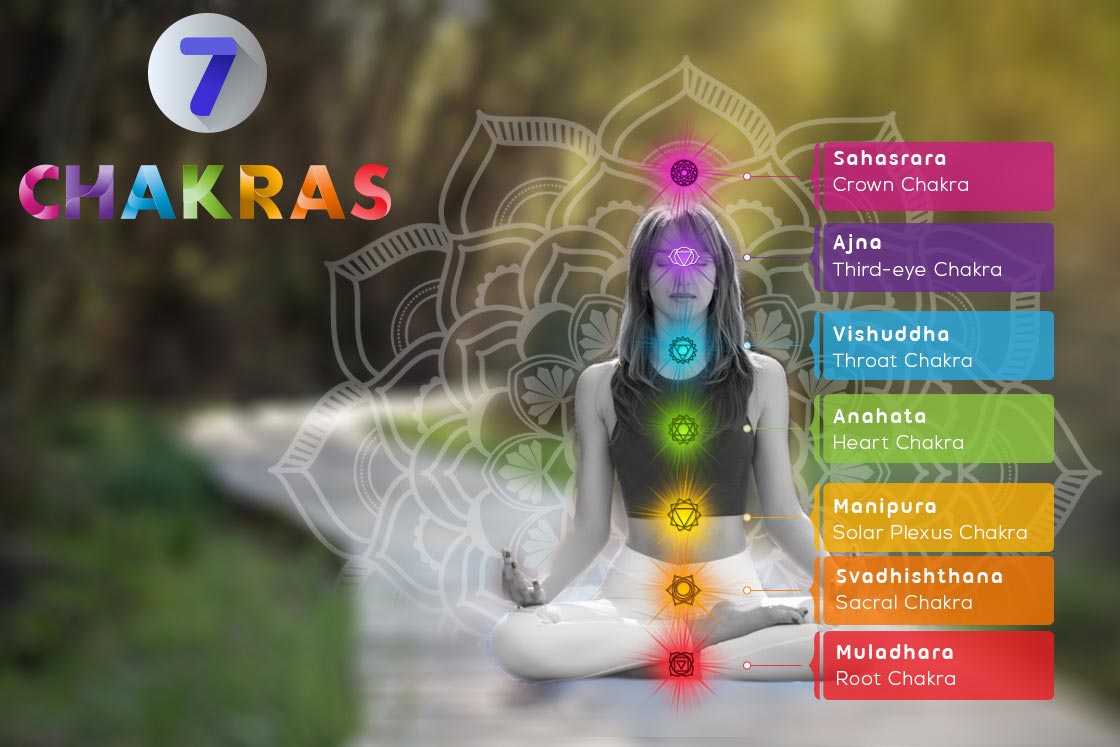
There are 3 main Nadis in the subtle body along the spinal cord: Ida (left side), Pingala (Right side), and Sushumna Nadi (Central).
7 Chakras are the converging point of Ida and Pingala Nadis which are the source of Sun and Moon energy in the body. Joining sun and moon energy at these places produces a powerful vortex of energy; hence it’s called ‘7 centers of energy’ (7 chakras).
Each Chakra has a different meaning & purpose which are identified by its unique characteristics.
Characteristics of 7 major chakras
It’s described using some key points. These are the following.
Location of Chakras: Location of a chakra represents the energy accumulation from massive nerves center at a specific position. These positions are 5 along the spine and rest 2 on the forehead and above forehead.
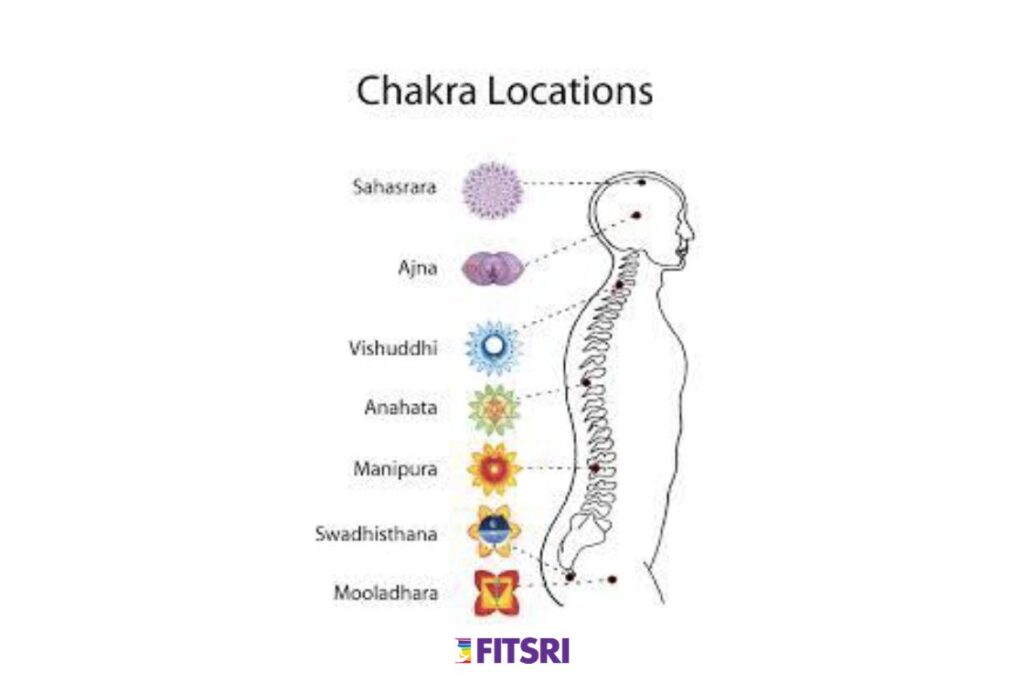
The element of Chakras: 5 elements of the physical body represents the first 5 chakras. The last 2 chakras (Ajna and Sahasrara) respectively the representation of the mental body and consciousness.
Number of Petals in Chakras: Chakra also called Lotus and there is a specific number of petals considered for each Lotus or Chakra.
These lotus petals signify the number of Nadis meeting at the junction point. Higher the number of petals of a lotus, higher is the energy associated with a specific chakra.
Sound or Mantra of Chakras: All the 7 Chakras stimulate corresponding to a particular set of frequencies. The vibrations of the corresponding chakra are resonated through each Beej mantra. Beej mantra with daily meditation balances the energy of each chakra.
Color of Chakras: Energy emitted through each chakra gives a specific color, called ‘chakra’s color’. This emitted color through each chakra usually indicates the emotions, physical & spiritual state of a human being.
Now, you’ve been introduced the basics of Chakras, let’s discuss in-depth how each chakra associated with physical, mental, and every other aspect of your life.
We are going to discuss the following points about each chakra
- Location and chakras element
- Chakras Symbol, Color, Mantra
- Signs of balanced and imbalanced Chakras
- Healing of blocked chakras
1st Chakra – The Root Chakra – Muladhara
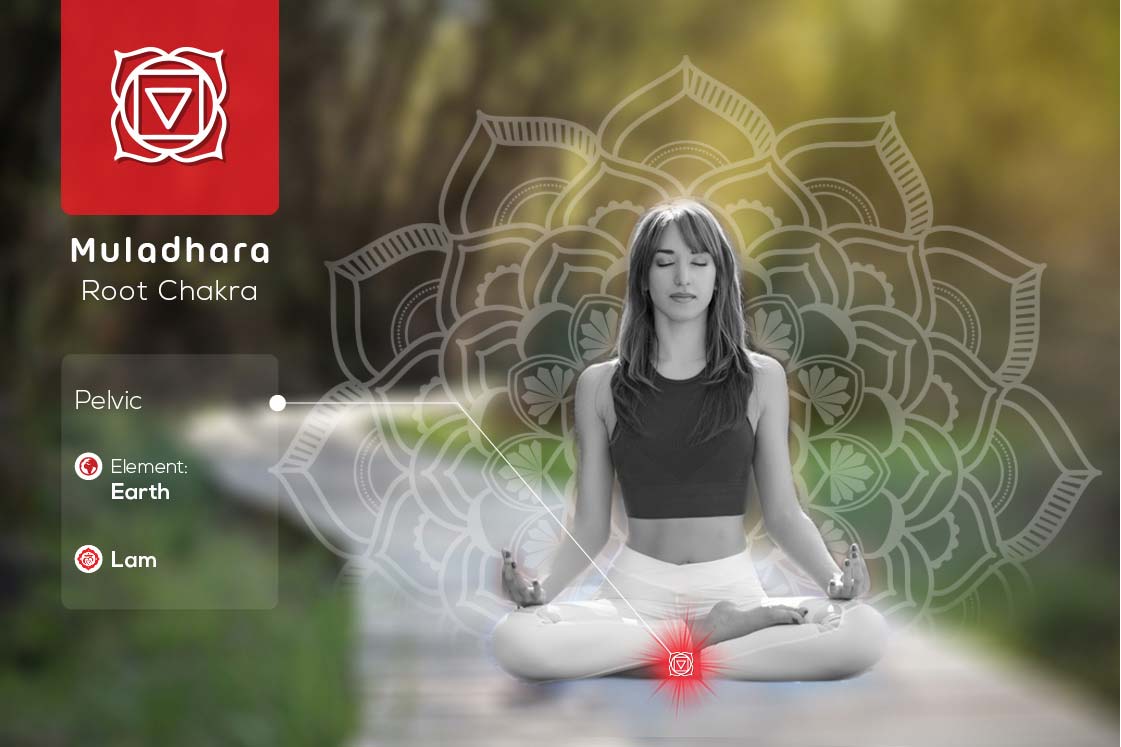
The meaning of Sanskrit term Muladhara denotes 1st Chakra significance i.e. Mula means Basic or Root and Dhara mean Support.
1st Chakra is responsible for the basic needs (Survival, Shelter, and Food) a person has to go through in their life. It defines our ability to survive and to stay grounded.
4 petals in the root chakra symbol show there are 4 subtle Nadis meetings at the base of the spine.
Qualities of Root Chakra
Root Chakra makes you familiar with qualities such as:
- Your ability to sense and smell
- Sense of security
- Your physical involvement in the outer world.
- Your presence in the world by helping you stay grounded.
Read More: Root Chakra Characteristics
Signs of Balanced Root Chakra
In a state of the balanced root chakra
- You would experience vitality & feeling of the responsibility
- Sense of security being grounded and connected with earthly elements will grow
- Tend to be more satisfied while striving to meet the needs to survive
Signs of Overactive Root Chakra
When root Chakra is overactive,
- You are more likely to grow as a fearful individual
- Problems associated with Spine, Kidneys, Prostate, and Suprarenal Glands working becomes more common for you
- Over possessive mind
- Anxiety becomes common as it comes with fear
- Unaccomplishment for the basic needs to survive
When root Chakra is overactive, Individual’s endeavor should bypass the excessive energy from it to other underactive chakras and hence, make it balance.
To balance an overactive root chakra
- Bring yourself forward to act of kindness,
- Connecting yourself with earthly elements,
- Channelize your energy into works like gardening, planting or walking.
Read More: A Quick Guide to Balance Root Chakra
Signs of Underactive Root Chakra
Being in a deficient state of Root Chakra can lead you to
- Feel homelessness (insecurity),
- Depression and thus not being able to be grounded,
- Lack of strength for any work,
- Misunderstanding which even can make you feel like a victim.
How to Energize Underactive Root Chakra –
There are three different ways to energize your deficient root chakra:
- By chanting the seed sound (Bija Mantra) Lam
- By eating red-colored/Root vegetables such as Radish, carrot, Potato, Tomato, Cherries, strawberries, etc.
- By wearing stones/Gems like Bloodstone, Red Jasper, and Black Tourmaline that help stimulate Root Chakra.
2nd Chakra – The Sacral Chakra – Svadhishthana
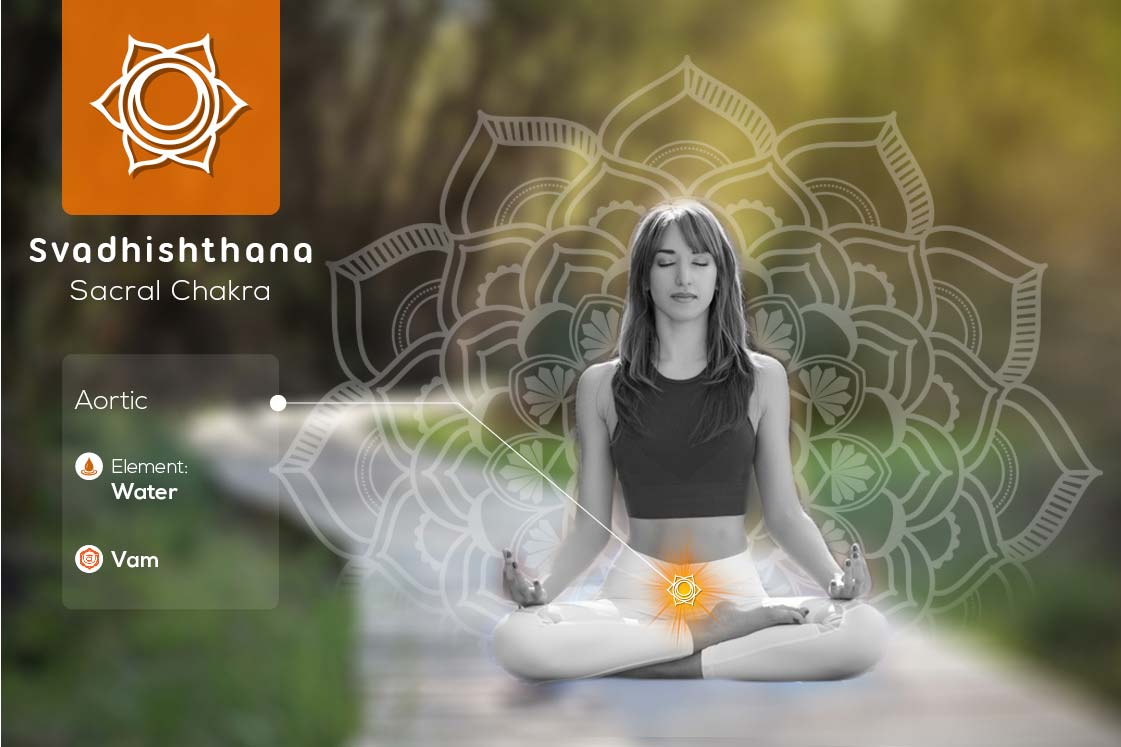
Located below the belly button and extended to its center, the 2nd in 7 chakras is – Svadhishthana Chakra.
Svadhishthana – Sva (One’s Own) + Adhishthana (Place). Also, sometimes it’s meaning derived from the world ‘Svad’ means ‘Activity of taking pleasure.’
Concluding meaning of the word Svadhishthana, 2nd Chakra is all about making you realize your identity as a human, son, brother, friend or a father, etc. with the world surrounding you.
Symbol of Sacral Chakra contains up-turned silver crescent moon inside an orange color circle. The silver crescent moon represents the water element of the sacral chakra. Also, 6 lotus petals cover circle circumference in which a unique Sanskrit syllable has written.
Qualities of Sacral Chakra
Qualities of Sacral Chakra associated with:
- Your ability to make decisions based on the response influenced by intelligence.
- Sense of sexual activity and expression is also the quality of sacral chakra.
- Your intuitional and creativity.
Sign of Balanced Sacral Chakra
Depression is literally a closing down of this chakra’s energy says Ambika Wauters in her book “Healing with Energy of Chakras”.
Following signs are helpful in identifying if you have balanced sacral chakra
- A balanced sacral chakra let you enjoy every pleasure of life without being addicted or overdoing to it,
- You are more humble and strong at maintaining relations with people near you,
- Your perception towards the world and to yourself is the same hence building friendly and joyful bonds.
Signs of Overactive Sacral Chakra
When over energy is flowing through Sacral Chakra =
- You are more possibly to turn into a manipulative person
- Physical symptoms include – obesity, hormone imbalances, and restlessness
- With an overflow of energy through 2nd chakra, you become addicted to pleasures
- A person becomes lustful, and selfish person with an urge to be controllable.
How to Balance Sacral Chakra
To balance 2nd Overactive Chakra,
- Redirect the overactive energy of it in nearby chakra. For this, withdraw from addicted means of pleasures and be more grounded with natural things.
- Consider every action based on whether it’s healthy or nourishing for you, if not, skip it.
Signs of Underactive Sacral Chakra
You will start feeling the following signs when there is a deficiency of energy in Sacral Chakra
- Heeding to the practical things while forget to enjoy the process of working on something
- Physically you will suffer from low back pain, sexual dysfunction, and lack of sense of taste
- Psychologically you become emotionally unstable, have trust issues, and lack of passion
How to Energize Underactive Sacral Chakra –
Following practices are helpful to restore the energy state of Sacral Chakra.
- Reciting the seed sound “Vam” regularly while meditating.
- Keeping yourself close to water and water bodies is a way to level the depreciated level of energy (since the element of Sacral Chakra is water).
- Gems like Orange Aventurine, Orange Carnelian, Citrine, Orange Calcite, and Coral Calcite can help up the level of your Sacral Chakra
Energy.
Read More: Sacral Chakra Comprehensive Guide
3rd Chakra – The Solar Plexus Chakra – Manipura
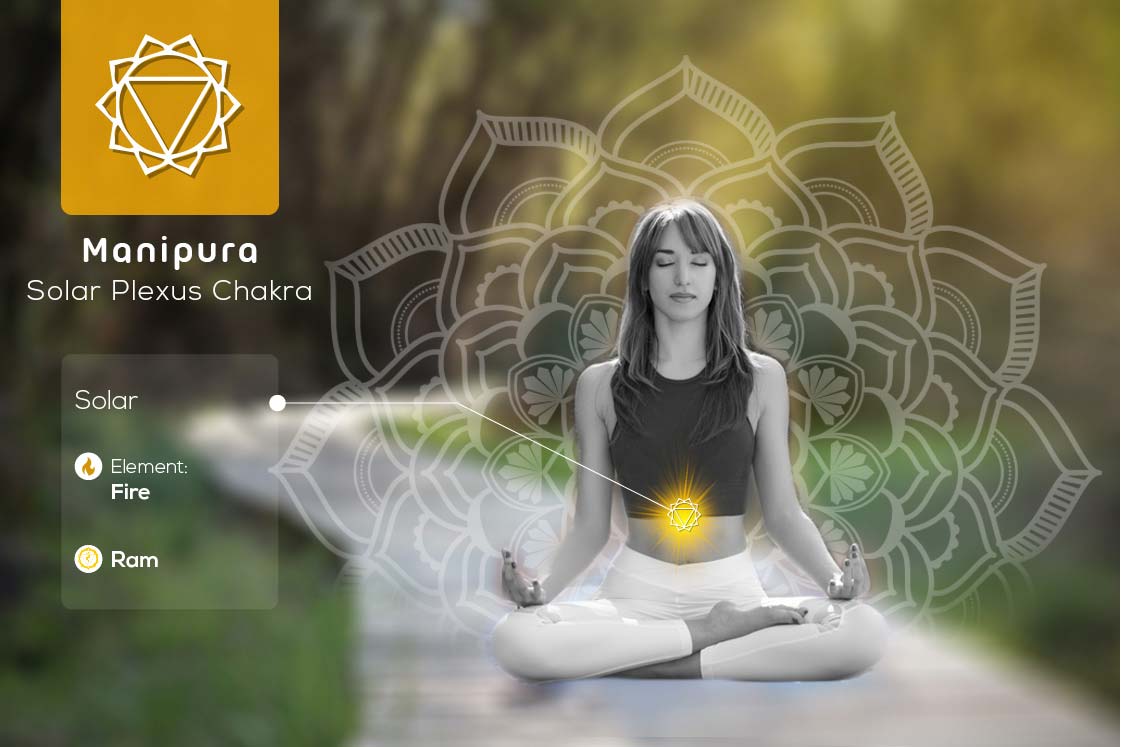
The third Wheel of life is denoted by Manipura, which sits right at the center of the body. It is placed directly above the navel also associating itself with your digestive system.
‘Manipura‘ means the ‘Lustrous Gem‘ which is located in the center of the body. It has a symbol of a descending red triangle inside the circle that signifies your will power and individual identity.
The 10 number of Petals represent ten Pranas of vibrations in Solar plexus chakra. It has a yellow color comparing your light to that of the sun. The bright yellow color stands for the energy you hold for your personal and professional growth.
Its principal element is Fire associating with body organs Pancreas, Stomach, Liver, and Gall Bladder.
Qualities of Solar Plexus Chakra
The qualities associated with the Solar Plexus Chakra are:
- It is the meeting point of Prana and Apana (the second life force of total five i.e., Prana, Apana, Vyana, Udana, and Samana).
- Your consciousness and will power.
- It is linked with your ego and exertion of will power and self-control.
- Distribution of Nourishing elements in the body.
Signs of Balanced Solar Plexus Chakra
The following states indicate that your third Wheel is balanced.
- When you feel more determined and self-confident in whatever you do.
- Your will to seek the truth about your life grows further.
- You become more decisive, self-controlled, and affirmed about your intention and actions.
Signs of Overactive Solar Plexus Chakra
In the overactive state of Solar Plexus Chakra:
- You tend to become excessively authoritative and try to get control over people or surroundings.
- You try to speculate things more logically.
- Making plans and rigid limits over yourself are one of the examples of the overactive state of Solar Plexus Chakra.
Getting angry over little things is one of the most common issues arising due to the excited state of Manipura Chakra.
How to Balance Solar Plexus Chakra –
To ground the overactive Solar Plexus Chakra, you need to:
- Open up yourself with love and kindness to others.
- Show compassion and empathy for others as well as yourself.
- Give more time to yourself to realize your actions and assess them.
- Your actions must be such that they do not affect people in your surroundings negatively.
Signs of Underactive Solar Plexus Chakra
You are easily depressed when you go through a deficient state of Solar Plexus Chakra.
- In this state, you become less confidence; hence, losing your decision-making ability.
- You grow to become shyer and are unable to speak out your concern.
- You lose your ability to realize your self-worth, are more submissive, and less likely to respect yourself.
How to Energize Underactive Solar Plexus Chakra –
- Since the Bija Mantra associated with Solar Plexus Chakra is “Ram” chanting this seed sound is helpful to restore this Wheel to the energized state.
- The yellow-colored foods help stimulate the Underactive Solar Plexus Chakra. You can enrich your diet with turmeric, and eat yellow colored-fruits and vegetables. Cereals, flax seeds, and rice to boost your Manipura Chakra.
- Crystals that stimulate your Solar Plexus Chakra are Amber, Citrine, Lemon Quartz, Yellow Jasper, and Yellow Tourmaline.
Read More: Solar Plexus Chakra Guide
4th Chakra – The Heart Chakra – Anahata
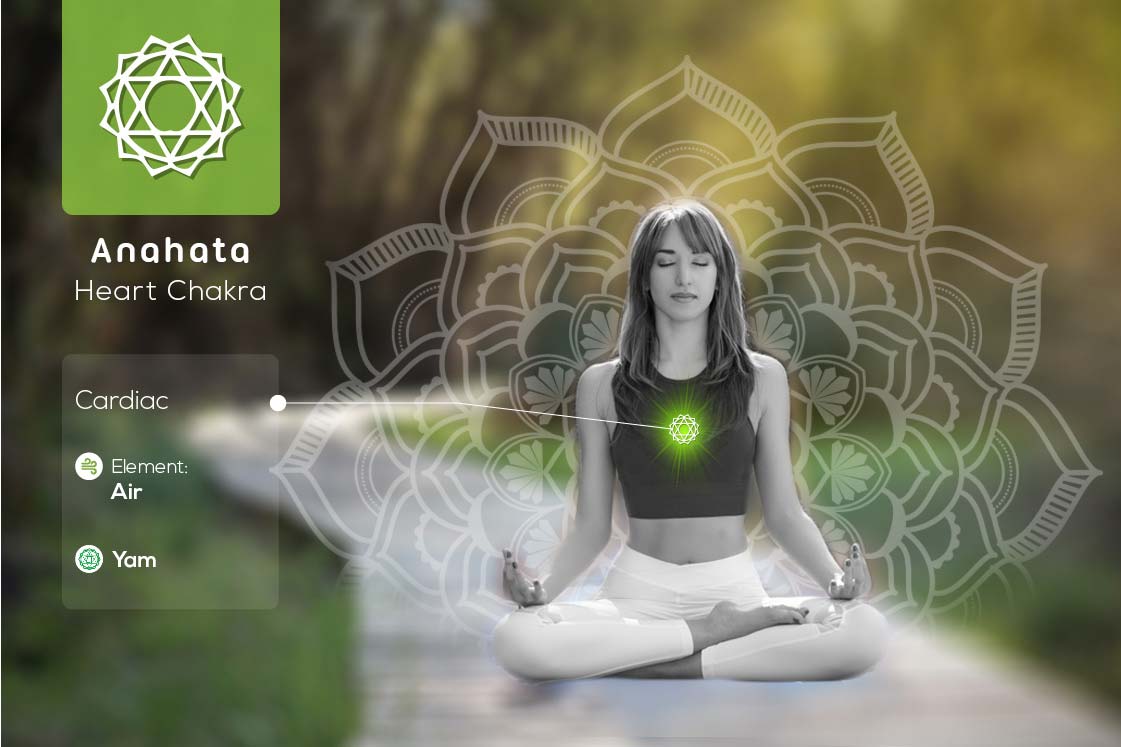
The Fourth in the Seven Major Chakras is represented by green color which signifying the free flow of energy like air, hence has air as its element.
The symbol of heart chakra denoted with 12 Lotus Petals.
Heart Chakra encompasses the areas surrounding the heart, which are Lungs, thymus, and liver. Since this Chakra is in line with heart, it is also associated with blood circulation.
Qualities of Heart Chakra
- Ability to maintain relationships with people
- It’s the center of your awareness and insight integration
- How you love others and yourself determined through the Heart chakra
Read More: Heart Chakra Characteristics
Sign of Balanced Heart Chakra
- One tends to feel love and compassion for yourself as you do for others.
- You treat everyone with unconditional affection, selflessly with compassion, and devotion.
- No matter how tense or sparse your situation is, you still have empathetic thoughts for others.
Signs of Overactive Heart Chakra
You sense to have been undergoing an overactive Heart Chakra if:
- You overexpress your feelings.
- Become too judgmental and jealous.
- Unable to control your emotions or have grown too much affection to something or someone.
- You are undergoing a discerning relationships
- Your sentiments are ruling you.
- Saying yes has become your habit without even considering the pros and cons of it.
How to Balance Heart Chakra
You can bring your Heart Chakra to a Balanced State by:
- Treating yourself with some visits to nature.
- Learning to love yourself and letting go is the first way to bring the Anahata Chakra to Balance.
- Learn to say no at times when necessary. Sometimes it the best way to heed to yourself.
- Remain kind and compassionate to others even at your worst.
Read More: A Quick Guide to Balance Heart Chakra
Signs of Underactive Heart Chakra
The underactive heart chakra is when you experiencing:
- Lack emotions for others.
- You are hard to be kind to others or compassionate.
- It is hard to get involved in love relationships for you.
How to Energize Underactive Heart Chakra
You can raise your energy level of underactive Heart chakra using these simple acts.
- Green is the primary color, so have green food, take walks in the places full of greenery surrounding yourself with this color.
- Practice reciting the chant of “Yum” while meditating to up the level of heart Chakra.
- Wear gems that enhance your Heart Chakra namely Malachite (that prevents negativity from entering you and pacifying heart chakra energy level), Epidote (to enhance good intentions), and Chrysoprase (to bring more joy and positivity).
5th Chakra – The Throat Chakra – Vishuddha
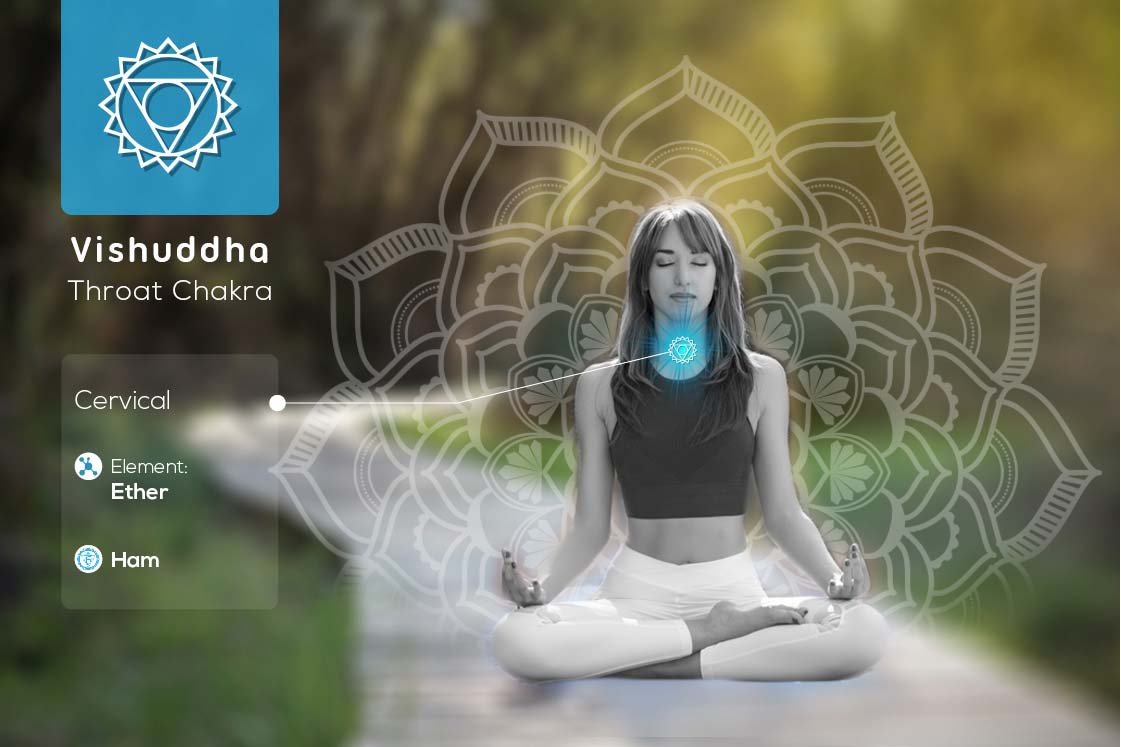
Vishuddha, the 5th chakra, means Purity and Clarity.
5th Chakra sits at the center of the neck on throat navel hence also known as Throat Chakra. Located in the vicinity of the vocal cords, the Throat Chakra signifies the ability to speak and hear the truth.
Throat Chakra symbol symbolizes using a circle inside a descending triangle with a crescent moon that defines your pure instinct and communication ability. It is identified by the color blue and has 16 Lotus petals.
The other names by which throat Chakra known are KanthPadma and ShodsashDala.
Qualities of Throat Chakra
- Your ability to express the truth and listen to the truth
- Ability to be creative and realize your purpose
- Defines verbal and non-verbal communication as well as internal and non-internal communication
Read More: Throat Chakra Characteristics
Sign of Balanced Throat Chakra
- You are more precise about your thought process and communication.
- Your creative side to the world is better reflected.
- You are affirmed about your purpose.
Signs of Overactive Throat Chakra
- Losing control over your speech.
- Your words sound hurtful.
- Manipulative words or thoughts start creeping into your mind.
How to Balance Throat Chakra
- Practicing to listen more and speak less
- Inculcating Patience and thinking about what you are to talk about and to whom
- Keeping close to the blue sky or ocean, since the blue color is the indicator of Throat Chakra
Read More: A Quick Guide to Balance Throat Chakra
Signs of Underactive Throat Chakra
- A slurry and less confident speech.
- Lack of ability to express yourself.
- Less communication with the people.
- Feeling scared while expressing your views.
How to Energize Underactive Throat Chakra –
Try these simple ways to amplify the deficient Throat Chakra:
- Get involved yourself in Art and creativity more.
- Chant the Bija Mantra (Seed Sound)- Hum/Ham often while Meditating.
- Wear Blue Stones and Gems that help you escalate the lower energy levels, which are: Azurite, Lapis, Turquoise, Lazuli, Sodalite, and Aquamarine.
6th Chakra – The Third-Eye Chakra – Ajna
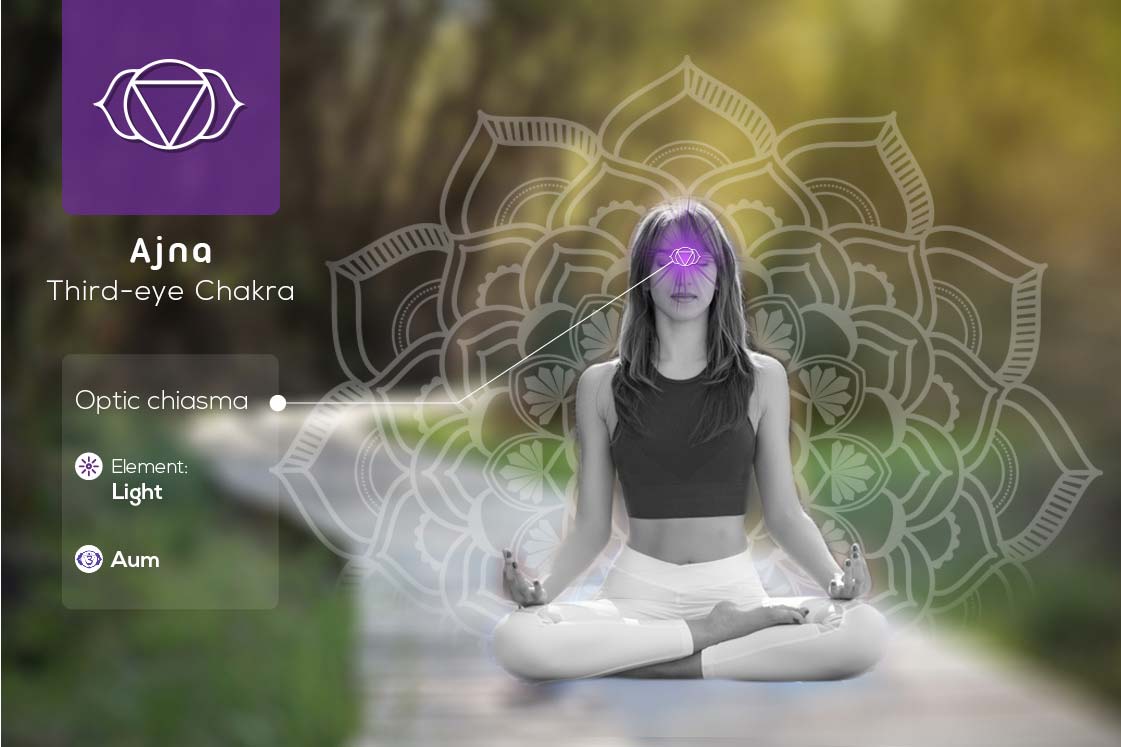
The Third-Eye Chakra is also known as Ajna Chakra located in the Centre of the forehead between the eyebrows. It is also referred to as the Brow Chakra due to its location (in the space between the eyes).
Components of the Ajna chakra symbol are 2 Lotus petals with a downward-pointing triangle under a circle. This symbol signifies the merging of two important nadis viz idea and Pingala at this point.
Ajna Chakra is connected with our lower brain, pituitary gland, spine & sixth sense. It affects the functions of eyes, ears, nose, pineal glands, and psychic or extrasensory perception.
Qualities of Third-Eye Chakra
- Ability to perceive the concepts between life and death through wisdom
- Visualizing the surroundings using the third eye that physically does not exist
- Recognizing patterns and correlating them to a bigger picture hence bringing clarity and subtleness
Read More: Third-Eye Chakra Characteristics
Sign of Balanced Third-Eye Chakra
- It is believed that once Third Eye Chakra gets balanced, your eyes reflect it with a sparkle.
- Your vision becomes far, and metabolism gets stronger with more strength generating in the upper body.
- Memory becomes sharper, and your tendency to think wisely and calmly is at its optimum.
Signs of Overactive Third-Eye Chakra
The overactive state of Third Eye Chakra has drastic effects on your psychological behavior. These include:
- Fantasizing more often.
- Continuous or excessive flow of thoughts can make you mentally drained.
- Even the easiest of decisions can be hard to take in the hyper state of Ajna Chakra.
- Hallucinations, Anxiety are the most common experiences of the excessive state of Ajna Chakra.
How to Balance Third-Eye Chakra –
- To calm the hyperactive state of this Chakra, connect yourself to ground.
- To balance this state, a simple way to bring a solution is to work on the lower level chakras (Heart, Throat, and Sacral).
- Get off the Decision-making chair and get some rest to let your senses get in line.
- Before judging others quickly, question yourself.
Read More: A Quick Guide to Balance Third-Eye Chakra
Signs of Underactive Third-Eye Chakra
This Chakra is said to be in a deficient state if:
- You feel intimidated by your thoughts often.
- Stress, Depression, and Anxiety are getting a daily business to deal with.
- It is hard to remember even the simplest things and events.
How to Energize Underactive Third-Eye Chakra –
Practice these to Vitalize your Third-Eye Chakra:
- Eat healthily and put some blueberries, raspberries, grapes, Wine, and blackberries on your table.
- Chant the Seed Sound “Om/Aum” associated with Ajna Chakra frequently while meditating.
- Wear Third-Eye Chakra Stones to bring the Ajna Chakra to the Vital State, namely Indigo/Blue Kyanite, Phenacite, Satyaloka Quartz, and Tanzanite.
Read More: Ajna Chakra Comprehensive Guide
7th Chakra – The Crown Chakra – Sahasrara
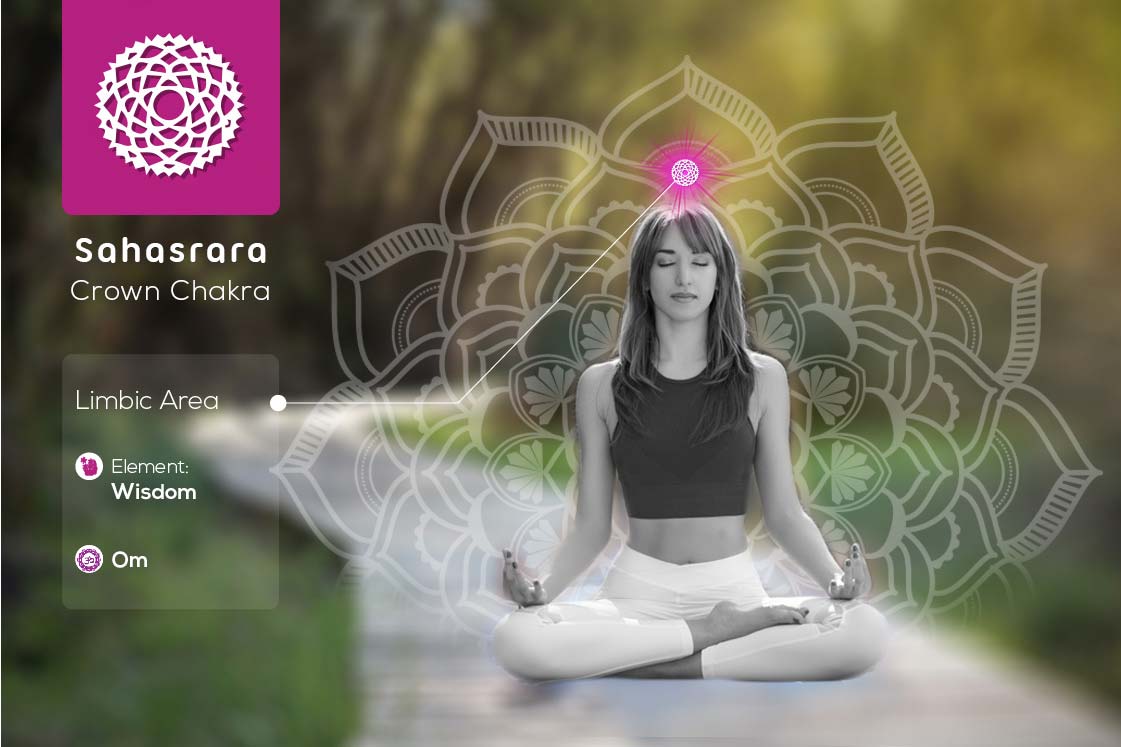
The final and the topmost Chakra that sits outside of the body is The Crown Chakra. This Chakra is also known as Sahasrara translated into a Thousand Petals.
The violet color indicates of this chakra represents your presence of being beyond the physical connections.
Crown Chakra is the Centre where all the lower level Chakras integrate with their respective traits. It is said that once you master your lower level chakras, you are more likely to balance your Crown as well.
Qualities of Crown Chakra
- This Chakra defines your state of consciousness and is considered as the gateway to meet the divine self
- The energy associated with Crown Chakra unravels the mystery of the universe through harmony and oneness
- Crown Chakra helps you drop your pride and ego and think beyond selfishness and other confinements
Read More: Crown Chakra Characteristics
Sign of Balanced Crown Chakra
There has not been any tangible evidence yet as who has reached this energy level so far. But when your Crown Chakra is balanced,
- You attain the highest level of consciousness and enlightenment.
- You feel most joyful, peaceful, happiest feeling connected with universal creatures.
- Expecting nothing in return, you envision everything and everyone equally.
Signs of Overactive Crown Chakra
- Though it is said that you can turn into an egomaniac, proud, and selfish with the intention to rule once you experience an overdrive of the Sahasrara.
- This is where you are most likely to misuse your power and senses.
How to Balance Crown Chakra –
In case of an overactive Crown Chakra, you need to descend your energy to the lower parts of the ladder to bring the Crown Chakra to a calming level.
- Think about the Universal principle, everything is connected, and we are all made of the same elements.
- Live in gratitude, learn to trust more, and once you realize you have everything to survive, help others in need with what you have.
- Go out facing the sun, let the light shine on you.
Read More: A Quick Guide to Balance Crown Chakra
Signs of Underactive Crown Chakra
- It is considered normal to experience the underactive state of Crown Chakra.
- In some cases, the underactive state can lead you to remain aloof and disconnected.
- You are least likely to experience any spiritual connection.
- Loneliness and meaninglessness are the common traits of a deficient Crown Chakra State.
- When you possess wisdom and knowledge, but you don’t agree to share it with others.
How to Energize Underactive Crown Chakra –
The first step to work towards enlightenment is to let the ego vanish. (I am the same as everyone, I know my purpose, I serve my purpose without expectations).
- To vitalize your underactive Crown Chakra, practice reciting Bija Mantra “Om/Aum” while meditating.
- Wear Kyanite to enhance the energy-level of Crown Chakra.
- Eat herbal foods like Sage, Juniper, Myrrh, and Copal to restore your energy level.
Read More: Sahasrara Chakra Comprehensive Guide
Conclusion
There is always a fight between balance and imbalance. When your chakras are aligned and open, your mind body and soul are at their healthiest level.
However, imbalances tend to manifest themselves and that is when problems arise. You feel defeated, lethargic, unhappy and depressed. Overcoming them is not always about taking medicine. Sometimes the answer is very simple and requires a little physical activity.
And yet other times it becomes necessary to supplement it with medical care. Whatever be the problem, most things can be healed by opening up your chakras. Don’t be cynical and rule out the goodness of yoga. Learn more about it and embrace it in your lives to make it more worthwhile.


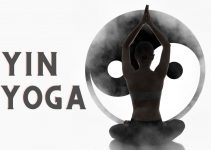


Can sudden activation of chakras lead negative impact on mental and physical self. Because we are not used to that energy and we put more efforts without realizing the outcome and not able to control the power come with it.
Great summary on the topic of chakra, well design too.
Can a person show the signs of a chakra being over active and underactive at the same time? If yes what does that mean?
Excellent presentation i am interested the corresponding mantras of the 7 chakras?
thank you.
The basic mantras correspondence to 7 chakras are actually Beej mantras of each chakra. You can learn more about beej mantras for chakras here!
Thank you so much for the article
thank you so much ..
Well defined article on Chakras for common understanding. Thank you Ashish
This was great about chakras.
Thankful